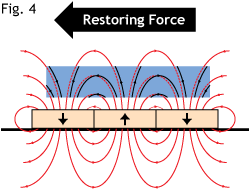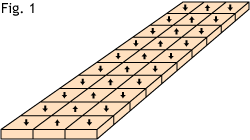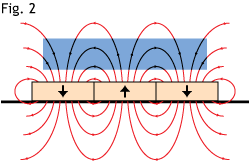Levitation using high-temperature superconductors
|
Our magnetic levitation demonstration consists of two parts:
(i) A magnetic track made of approximately 800 rare earth magnets.
(ii) Superconducting yttrium-barium-copper-oxide (YBCO) with a critical temperature of 93 K (-292 F) and cooled by liquid nitrogen.
|
When a superconductor such as YBCO is cooled below its critical temperature it looses all electric resistance.
In addition to the remarkable electric properties, superconductors also respond to magnetic fields in interesting and
useful ways, making this levitation demonstration possible.
Briefly, the magnetic fields causes electrical tornadoes or vortices in the superconductor, and if these vortices are
pinned to impurities or imperfections it is possible to make a magnetic "imprint" in the superconductor.
Below we explain the principle behind the levitation in more detail.
|

|
|
The track (Fig. 1) is made up of several hundred individual magnets organized in three parallel rows, oriented such
that the magnetic field is directed up at the center and down at the edges. This creates a magnetic field that is
invariant along the track direction but reverses in the perpendicular direction.
Figure 2 shows a side view of the magnetic track and the superconductor (shown in blue). The magnetic field lines
due to the track are shown as red lines.
When the superconductors is cooled below the critical temperature in the presence of the track's magnetic field
vortices (black lines) are nucleated in, effectively freezing in an imprint of the magnetic field.
Due to the large degree of imperfections in the YBCO material the vortices are strongly pinned, and will remain even if the
superconductor is moved away from the magnetic field of the track (Fig. 3).
|
|
|
|
A slight displacement of the superconductor above the track leads to a mismatch of the magnetic field and the
"frozen in" vortices, and give rise to a restoring force which seeks to realign the two (Fig. 4).
The restoring force acts both perpendicular to the track as well as in the vertical direction. Only along the
direction of the track is the magnetic field uniform (Fig. 1) and the superconductor is free to move.
|

|
You can also click here for a poster with more in-depth explanation of superconductivity,
vortices and levitation.
|
|
Here is a picture and some videos that show our levitation track:
|

|
|
|
|
|
|
The track was built by Notre Dame undergraduates Nick Anderson and Chris Torres.
Pictures and videos by Alan Leishman and Morten Eskildsen.
|
|

|
This demonstration was developed as a part of the project entitled "Vortices and the Interplay between Superconductivity and Magnetism" and funded by the National Science Foundation through grant no. DMR-0804887.
|
|







